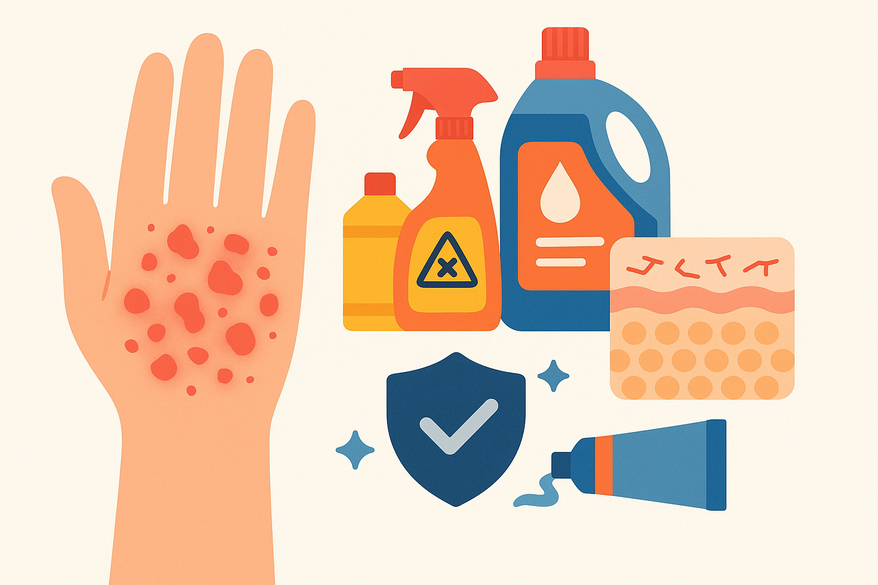Understanding and Managing Household Chemical Dermatitis
Learn about household chemical dermatitis, its causes, symptoms, and treatment options. Discover preventive measures to protect your skin from irritation.

Estimated reading time: 6 minutes
Key Takeaways
- Household chemical dermatitis arises from irritants and allergens in everyday cleaning products.
- Symptoms range from acute redness and itching to chronic dryness, scaling, and blisters.
- Diagnosis involves a thorough history, physical exam, and patch testing.
- Treatment includes immediate rinsing, cool compresses, topical corticosteroids, and prescription therapies for severe cases.
- Prevention relies on protective gear, safe handling, proper storage, and diligent skin-care routines.
Table of Contents
- Understanding Household Chemical Dermatitis
- Causes and Triggers
- Signs and Symptoms
- Diagnosis and When to Seek Medical Advice
- Treatment Options
- Prevention and Safety Measures
- Additional Tips
- FAQ
Understanding Household Chemical Dermatitis
Household chemical dermatitis is a form of contact dermatitis triggered by exposure to cleaning agents, detergents, solvents, and fragrances found around the home. It can manifest as either:
- Irritant contact dermatitis: Direct toxic effect on skin cells—common culprits include soaps, detergents, and solvents that strip lipids and denature proteins.
- Allergic contact dermatitis: A true immune reaction to allergens such as fragrances, preservatives, or latex, mediated by T-cell activation.
Causes and Triggers
Key household chemicals to watch out for include:
- Cleaners like bleach (sodium hypochlorite) and ammonia solutions
- Detergents and soaps containing sodium lauryl sulfate
- Disinfectants with quaternary ammonium compounds (benzalkonium chloride)
- Fragrances such as limonene and linalool
- Preservatives (formaldehyde, parabens)
- Latex rubber proteins in gloves and sponges
Exposure can occur through direct contact or residual films on dishes and surfaces. Risk factors include pre-existing eczema, frequent wet work, and skipping moisturizers.
Signs and Symptoms
- Acute: Redness, swelling, itching, stinging, or burning at the contact site.
- Chronic: Dry, cracked, scaly patches and lichenification from scratching.
- Severe: Blisters, weeping sores, painful fissures.
- Irritant reactions appear quickly and stay localized; allergic reactions are delayed (24–72 hours) and may spread.
Diagnosis and When to Seek Medical Advice
- Medical history: Record all products, timing, and prior skin issues.
- Physical exam: Assess rash distribution, appearance, and texture.
- Patch testing: Identifies specific allergen triggers.
For quick, AI-powered insights alongside your clinical evaluation, consider using Rash Detector:

Red flags—see a doctor if: the rash is severe or widespread, shows signs of infection (pus, fever), appears on sensitive areas, or recurs without clear cause.
Treatment Options
Act promptly to soothe skin and halt the reaction:
- Rinse with lukewarm water and mild soap within 1–2 minutes of exposure.
- Apply cool, wet compresses (10–15 minutes, 2–3 times/day).
- Use OTC 1% hydrocortisone cream up to 4 times daily (limit 2 weeks); for more, see best anti-itch cream solutions.
- Oral antihistamines (cetirizine, loratadine) can ease itching.
Severe cases may require prescription topical steroids, oral prednisone taper, calcineurin inhibitors, wet wrap therapy, or phototherapy. Treat secondary infections as needed.
Prevention and Safety Measures
- Wear nitrile or vinyl gloves instead of latex.
- Use long sleeves, goggles, or face shields for splashes.
- Read labels, dilute concentrates properly, and never mix bleach with ammonia.
- Work in well-ventilated spaces.
- Store chemicals in original containers, out of children’s reach.
- Wash hands with pH-balanced mild soap and apply moisturizer within 3 minutes; for suggestions, see fragrance-free moisturizer suggestions.
Additional Tips
Pro Tip: Keep a “reaction diary” logging products, ingredients, brands, and symptom timelines to pinpoint your triggers over time.
FAQ
- Can I develop dermatitis from a chemical I’ve used for years?
- Yes. Delayed sensitization can occur after repeated exposures, even to products you’ve tolerated before.
- I have eczema—am I at higher risk?
- Yes. Pre-existing eczema weakens your skin barrier and heightens sensitivity to both irritants and allergens.
- Are natural or DIY cleaners safer?
- Not always. Vinegar (acetic acid) and essential oils (lemon, tea tree) can also irritate or sensitize skin.





